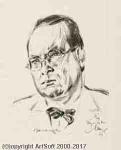Willi Baumeister
Willi Baumeister
Style: Art Informel;
Born: 1889
Death: 1955
Biography:
Willi Baumeister was a German painter, scenic designer, art professor, and typographer.
Willi Baumeister, born in Stuttgart in 1889, completed an apprenticeship as a decorative painter in his native city from 1905 to 1907, followed by military service (fall 1907–1908). During his apprenticeship, Baumeister also began art studies at the Stuttgart Art Academy (Königlich Württembergische Akademie) (1905–1906), attended Robert Poetzelberger’s drawing class, and took additional lessons from Josef Kerschensteiner. In 1906 he resumed his apprenticeship and, in 1907, completed the trade test.
Following his military service, Baumeister continued his studies at the art academy. Dismissed by his teacher Poetzelberger due to lack of talent, he switched into the composition class of Adolf Hölzel, with whom he studied until 1912, where he met his lifelong friend, Oskar Schlemmer. Baumeister took his first trip to Paris in 1911, successfully participated in a gallery exhibition in Zurich in 1912 and a year later participated in Der Erste Deutsche Herbstsalon (The First German Autumn Salon) in the Berlin gallery Der Sturm. There he met the expressionist painter Franz Marc. In 1914 Baumeister had his first solo exhibition at Der Neue Kunstsalon (New Art Salon) in Stuttgart. In the same year, Adolf Hölzel arranged a commission for wall paintings at the Deutsche Werkbund-Ausstellung (German Werkbund Exhibition) in Cologne for Baumeister, Schlemmer, and Herman Stenner. Prior to being drafted into the army in the summer of 1914 (until 1918), Baumeister travelled to Amsterdam, London, and Paris. During the war, Baumeister met the painter Oskar Kokoschka and the architect Adolf Loos in Vienna in 1915. In 1916 he participated in the exhibition Hölzel und sein Kreis (Hölzel and his Circle) at the Art Association in Freiburg im Breisgau, which was subsequently shown at the Ludwig Schames Art Salon in Frankfurt am Main. In 1918, still prior to being discharged from military service, he threw an exhibition with his friend Oskar Schlemmer at the Galerie Schaller in Stuttgart. Baumeister and Schlemmer campaigned to bring Paul Klee to the Stuttgart Academy, which was rejected by the Academy. Klee, for his part, would have been willing to come. In 1919 Baumeister became a member of the Berlin artist association Novembergruppe (November Group). The group was founded by Max Pechstein in 1918, immediately following Germany’s capitulation and the fall of the monarchy. It remained one of the most important alliances of German artists until 1933.
In Stuttgart in 1919, Baumeister took up the initiative with Schlemmer and other artists to found the artist group Üecht (Alemannic: genuine, true), which he left in 1921. In 1919 he produced his first stage design, which was followed by seventeen others. In 1920 Baumeister completed his art studies, worked as an independent artist, and participated in exhibitions in Berlin, Dresden, and Hagen. His popularity and recognition abroad became evident in a joint exhibition with Fernand Léger in the Berlin gallery Der Sturm in 1922. During these years, Baumeister developed professional relationships with artists such as Paul Klee, Léger, Le Corbusier, Amédée Ozenfant, and Michel Seuphor. In 1924 several of his works were shown at the Erste Allgemeine Deutsche Kunstausstellung (First General German Art Exhibition) in Moscow and, in 1925, he participated in the Paris exhibition L’Art d’aujourd’hui (Art Today). Alongside his artistic work, he was also active in the area of commercial art and designed advertisements for numerous companies, such as Bosch and DLW (Deutsche Linoleumwerke)
In 1926 Willi Baumeister married the painter Margarete Oehm (1898-1978) and was offered, in the same year, the opportunity to take part in the International Exhibition of Modern Art in New York, followed by a solo exhibition in Paris the following year, where he also participated in the Große Berliner Kunstausstellung (Great Berlin Art Exhibition) (with his own room), where he met Kasimir Malevich.
In 1927 Baumeister accepted a teaching post at the Frankfurt School of Applied Arts, later known the Städel. There he taught from 1928 a class in commercial art, typography, and textile printing. That very year, his daughter was born. The following year he turned down a position at the Bauhaus in Dessau. A member of the ring neue werbegestalter (Circle of New Commercial Designers) (chairman: Kurt Schwitters) since 1927, Baumeister joined the artist association Cercle et Carré (Circle and Square) in 1930. In the same year, he received the Württemberg State Prize for the painting Line Figure. After "Cercle et Carré", he also became a member of the artist association "Abstraction-Création" in Paris.
On 31 March 1933, following the National Socialist rise to power, Baumeister was dismissed from his professorship at the Städel. His colleague Professor Albert Windisch and Wilhelm Biering continued his lessons. Thereafter Baumeister earned his living mainly from commercial art, he was still however able to travel to Switzerland, Italy, and France. In the same year, his daughter Felicitas was born. In 1936 he was introduced by the Wuppertaler architect Heinz Rasch, with whom he work during the 1924 Exhibition in Stuttgart, to Dr. Kurt Herberts, the owner of a varnish factory in Wuppertal. He began working for the company in 1937, joining other artists ostracized by the National Socialist regime: Franz Krause, Alfred Lörcher, Georg Muche, and Oskar Schlemmer, and the art historian Hans Hildebrandt. That year five of his works were shown in the National Socialist exhibition Entartete Kunst (Degenerate art) in Munich.
More...
Wikipedia link: Click Here


